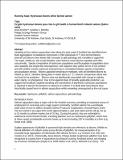Files in this item
Cryptic hydrozoan blooms pose risks to gill health in farmed North Atlantic salmon (Salmo salar)
Item metadata
| dc.contributor.author | Kintner, Anna | |
| dc.contributor.author | Brierley, Andrew S. | |
| dc.date.accessioned | 2018-11-21T00:49:07Z | |
| dc.date.available | 2018-11-21T00:49:07Z | |
| dc.date.issued | 2018-05-21 | |
| dc.identifier | 253222188 | |
| dc.identifier | 41068c34-64bf-431b-ab63-aed52db31b84 | |
| dc.identifier | 85047152821 | |
| dc.identifier | 000462532100026 | |
| dc.identifier.citation | Kintner , A & Brierley , A S 2018 , ' Cryptic hydrozoan blooms pose risks to gill health in farmed North Atlantic salmon ( Salmo salar ) ' , Journal of the Marine Biological Association of the United Kingdom , vol. First View . https://doi.org/10.1017/S002531541800022X | en |
| dc.identifier.issn | 0025-3154 | |
| dc.identifier.other | ORCID: /0000-0002-6438-6892/work/60427313 | |
| dc.identifier.uri | https://hdl.handle.net/10023/16512 | |
| dc.description | This study was made possible through a Marine Alliance for Science and Technology Scotland Prize PhD Studentship awarded to Anna Kintner in 2011, and was further supported with contributions from the School of Biology, University of St Andrews. | en |
| dc.description.abstract | Sampling at four salmon aquaculture sites along the west coast of Scotland has identified short-lived aggregations of planktonic hydrozoans (>280 individuals m−3), here termed blooms. Several such blooms were linked with increases in gill pathology and mortality in caged fish. Two types, Obelia sp. and Lizzia blondina, were found to cause blooms regularly and often concurrently. Species composition of hydrozoan populations and fluctuations in population sizes were spatially and temporally heterogeneous, with adjacent sites (within 30 km of one another and with similar oceanic exposure) experiencing no correlation between species composition and population density. Blooms appeared temperature-mediated, with all identified blooms by Obelia sp. and L. blondina taking place in water above 12 °C; however, temperature alone was not found to be predictive. Blooms were not significantly associated with change in salinity, water clarity, or photoperiod. Due to the apparent lack of broadly applicable predictors, we suggest that localized, targeted sampling and examination of planktonic hydrozoan populations is required to discern the presence or absence of a bloom. It is likely that many blooms have historically caused harm in salmon aquaculture while remaining unrecognized as the root cause. | |
| dc.format.extent | 12 | |
| dc.format.extent | 1518414 | |
| dc.language.iso | eng | |
| dc.relation.ispartof | Journal of the Marine Biological Association of the United Kingdom | en |
| dc.subject | Hydrozoan | en |
| dc.subject | Jellyfish | en |
| dc.subject | Salmon aquaculture | en |
| dc.subject | Gill pathology | en |
| dc.subject | QH301 Biology | en |
| dc.subject | SH Aquaculture. Fisheries. Angling | en |
| dc.subject | Aquatic Science | en |
| dc.subject | NDAS | en |
| dc.subject.lcc | QH301 | en |
| dc.subject.lcc | SH | en |
| dc.title | Cryptic hydrozoan blooms pose risks to gill health in farmed North Atlantic salmon (Salmo salar) | en |
| dc.type | Journal article | en |
| dc.contributor.institution | University of St Andrews. School of Biology | en |
| dc.contributor.institution | University of St Andrews. Marine Alliance for Science & Technology Scotland | en |
| dc.contributor.institution | University of St Andrews. Scottish Oceans Institute | en |
| dc.contributor.institution | University of St Andrews. Centre for Research into Ecological & Environmental Modelling | en |
| dc.contributor.institution | University of St Andrews. Pelagic Ecology Research Group | en |
| dc.identifier.doi | https://doi.org/10.1017/S002531541800022X | |
| dc.description.status | Peer reviewed | en |
| dc.date.embargoedUntil | 2018-11-21 |
This item appears in the following Collection(s)
Items in the St Andrews Research Repository are protected by copyright, with all rights reserved, unless otherwise indicated.

